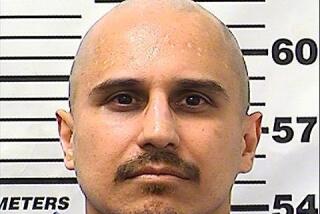DWP Agrees to Take Less Mono Lake Water : Resources: City plans to make up loss in reclamation effort. Environmentalists hail the landmark accord.
In a major breakthrough toward ending decades of bitter conflict over fragile Mono Lake, the city of Los Angeles agreed Monday to develop an alternative water supply for the city and permanently slash the amount of water taken from the scenic lake.
The city’s acrimonious 80-year water wars, which were immortalized in the film “Chinatown,” are far from over. But the agreement with environmentalists was hailed as momentous because it is the first time that the Los Angeles Department of Water and Power has voluntarily taken steps to restore environmentally sensitive Mono Lake.
“This is the political equivalent of the Camp David accord,” said Martha Davis, executive director of the Mono Lake Committee, a statewide environmental group that has battled the city for 15 years. “We still have our differences, but we set them aside to do something that is good for Mono Lake, good for California and good for the city of Los Angeles.”
Under the agreement, Los Angeles will permanently stop diverting one-third of the water it has historically taken from the Eastern Sierra brine lake. Instead, the city will build a $50-million project in the San Fernando Valley to distribute reclaimed waste water beginning in 1998.
The city has not taken water from the mountain streams that feed Mono Lake since 1989 because of a drought and numerous court victories by environmentalists. But Monday’s agreement is the first time that Los Angeles has voluntarily given up some of its long-held water rights and sought an alternate source.
The deal also breaks a deadlock over $36 million in special state funds, which has been waiting for the city for almost five years while the DWP and the Mono Lake activists argued over how to use it.
Gov. Pete Wilson, flanked Monday by an unusual bipartisan alliance of two dozen influential state legislators, city leaders and environmentalists, pledged his support for the East Valley Reclamation Project. Wilson called it “a victory for the people of Los Angeles and for every Californian” because it protects the popular lake while providing the city with treated waste water, which he called “water we cannot afford to waste, since we only used it once.”
The controversy over the high desert lake, which is famous for its bizarre, craggy tufa formations and as a sanctuary for vast numbers of sea gulls and migratory birds, is one of California’s longest-running environmental dilemmas. The lake is believed to be in serious ecological trouble from the city’s decades of water diversion, which environmentalists say have caused the water level to drop more than 40 feet.
The Legislature in 1989 authorized $60 million in state money for restoring Mono Lake, including $36 million for the city of Los Angeles to replace any water it gave up to help the lake. But to get the funds, the DWP and the Mono Lake Committee had to agree on a plan to use them. Distrust and hostility between the two sides ran so deep that it took more than four years for them to strike an agreement.
“Frankly, I never expected it to take so long to give away this money,” said Assemblyman Phillip Isenberg (D-Sacramento), who co-authored the legislation to give the city a financial incentive to cut its diversions from Mono Lake.
In the meantime, much of the state money has already been spent on other projects, so Wilson and the Legislature have to round it up elsewhere. Wilson said he is confident that $25 million in state money will be forthcoming for the East Valley Reclamation Project over the next four years given the unusually strong bipartisan support behind the agreement.
The city will use DWP funds to pay for the other half of the $50-million project, which will take 10 years to finish.
The break in the impasse came after Los Angeles Councilwoman Ruth Galanter brokered the negotiations, tackling what she called the “symmetrical paranoia” of both warring factions. Also, Mayor Richard Riordan appointed four new DWP commissioners who were willing to forget the bitter past and strike a deal.
“This is the first time the city has acknowledged there are other ways to get its water,” Isenberg said. “It took 15 years to batter down the bureaucrats and lead to this decision.” He called the city’s handling of Mono Lake a “legacy of land development and greed.”
Riordan called it a winning situation for everyone, especially since construction of the plant will create job opportunities and because it will provide the city a new drought-proof water supply.
“There’s only one loser here,” Riordan added, “and that’s our lawyers.”
Under the agreement, as the DWP builds pipelines and pumping facilities to make use of reclaimed water produced at the Tillman water reclamation plant in the Sepulveda Basin, it will gradually give up claim to 35,000 acre-feet of Mono Lake water a year, enough to serve nearly 70,000 households.
The fate of another 60,000 acre-feet of water the city holds the rights to will be decided next fall by the state Water Quality Control Board, which is writing new rules for how the Mono Lake stream water can be used.
The city’s largest source of water--the Owens River and a battalion of wells pumping aquifers beneath the Owens Valley--is unaffected by the Mono Lake agreement. Secret deals and strong-arm tactics used to acquire Owens Valley farms for their water rights early in this century earned Los Angeles the role of villain in most accounts of water wars in the West.
Only later were the streams feeding Mono Lake, in a separate watershed 50 miles farther north, diverted into the Los Angeles Aqueduct built across the Mojave Desert by famed engineer William Mulholland. In recent times the Mono Lake water has provided about 14% of the city’s supply.
The key aspect of the environmental controversy is the water level of Mono Lake. When the lake level drops too low, environmentalists say, the ecosystem that supports migratory birds suffers.
A court order in 1991 set the desired lake level at 6,390 feet above sea level. The DWP, however, contends that a level 15 feet lower is adequate to maintain the ecological health of the lake.
“We’re going to have a lot of problems in the future with water supplies without these diversions from Mono Lake,” said Dennis Tito, president of the DWP’s Board of Commissioners. “But in this day and age we have to face environmental concerns. We’ll just have to work to reclaim water and find ways to use less water.”
Within a week, the city and environmentalists expect to agree on other projects to make use of the remaining $11 million in state funds the Legislature authorized under the Isenberg bill. Improvements at a reclamation plant in South-Central Los Angeles and water conservation programs will probably be included, said Jerry Gewe, DWP’s engineer of water resources.
Daniel Taylor of the National Audubon Society, the lead plaintiff in the lawsuit to protect the lake, said the most important aspect of the agreement is that the city will not replace Mono Lake with water obtained from any other natural resource. Instead, the city plant will use waste water that now flows into the ocean.
“By investing in proven technologies of water conservation and reclamation, we can begin to fix some of the massive environmental problems associated with water diversions in our state,” Taylor said.
* WATER POLICY CHALLENGED: MWD complains over state allocations to farmers. A3
BACKGROUND
In 1989, a law written by Assemblyman Phil Isenberg authorized $60 million in state funds for projects to restore Mono Lake in the Eastern Sierra. That included $36 million for the Los Angeles Department of Water and Power to secure alternative sources of water, but the law required that the city and environmentalists agree on the projects. The two sides were unable to agree for more than four years, until Monday.
More to Read
Start your day right
Sign up for Essential California for news, features and recommendations from the L.A. Times and beyond in your inbox six days a week.
You may occasionally receive promotional content from the Los Angeles Times.






